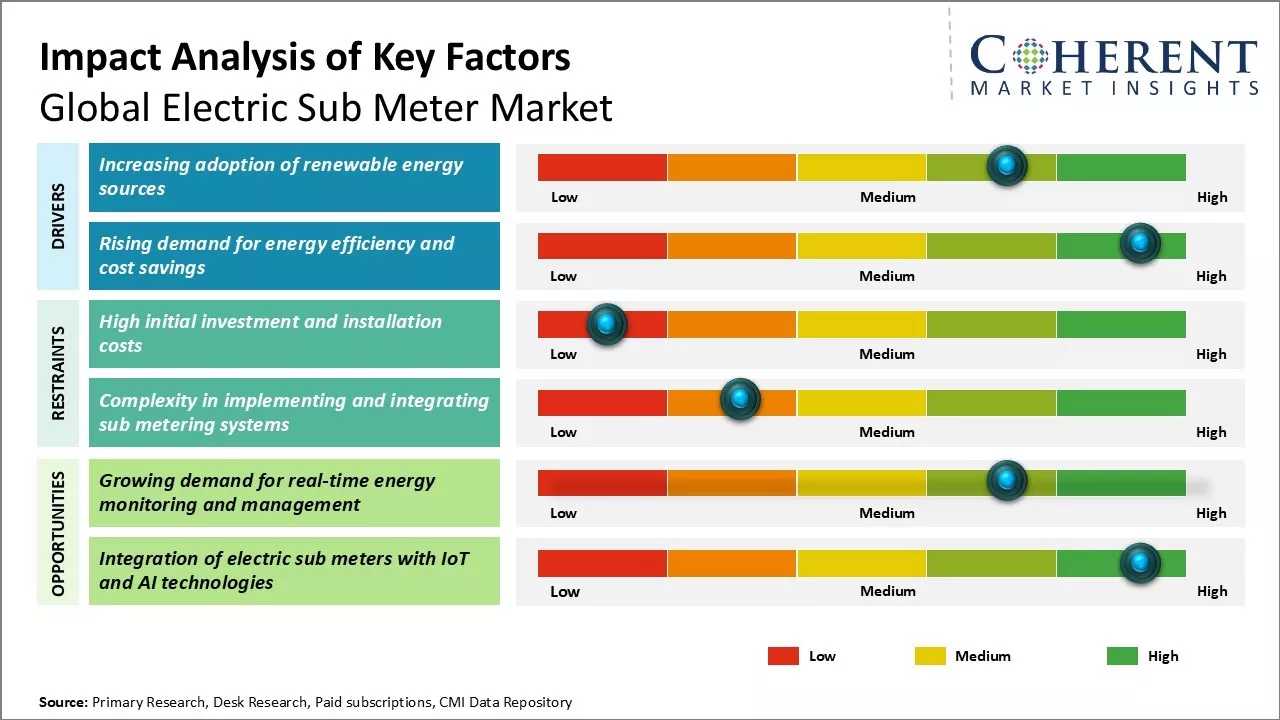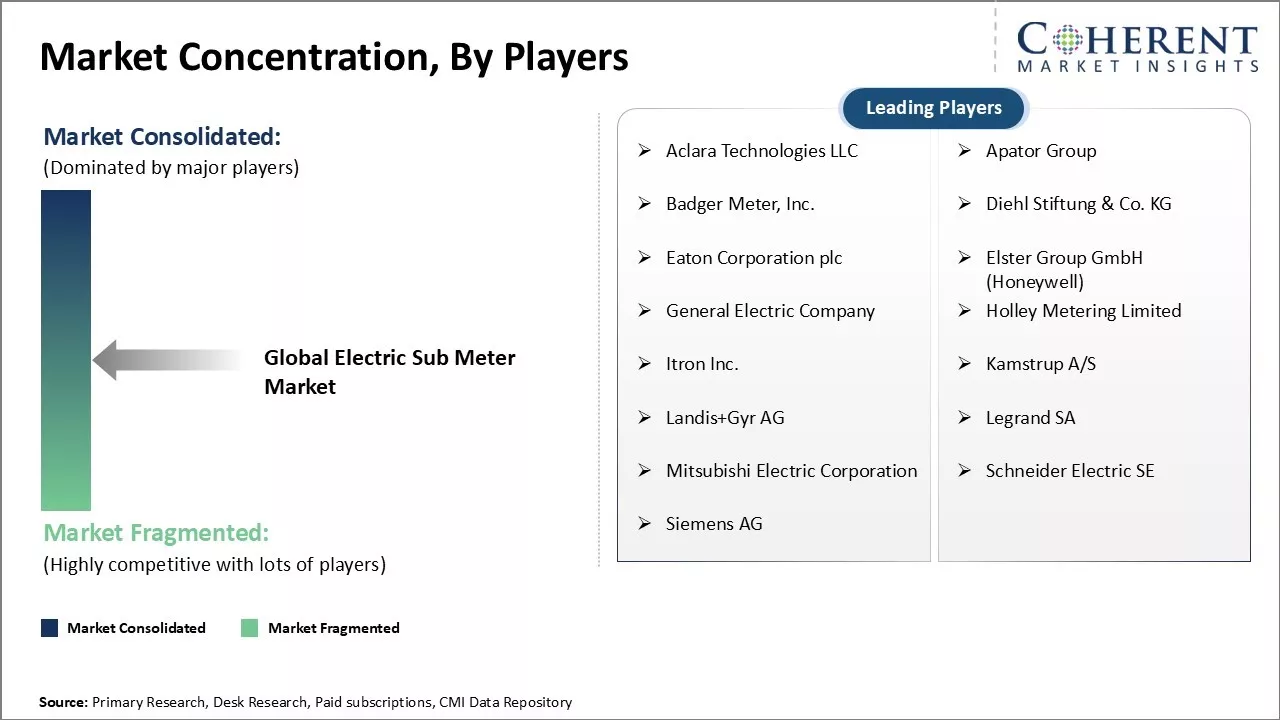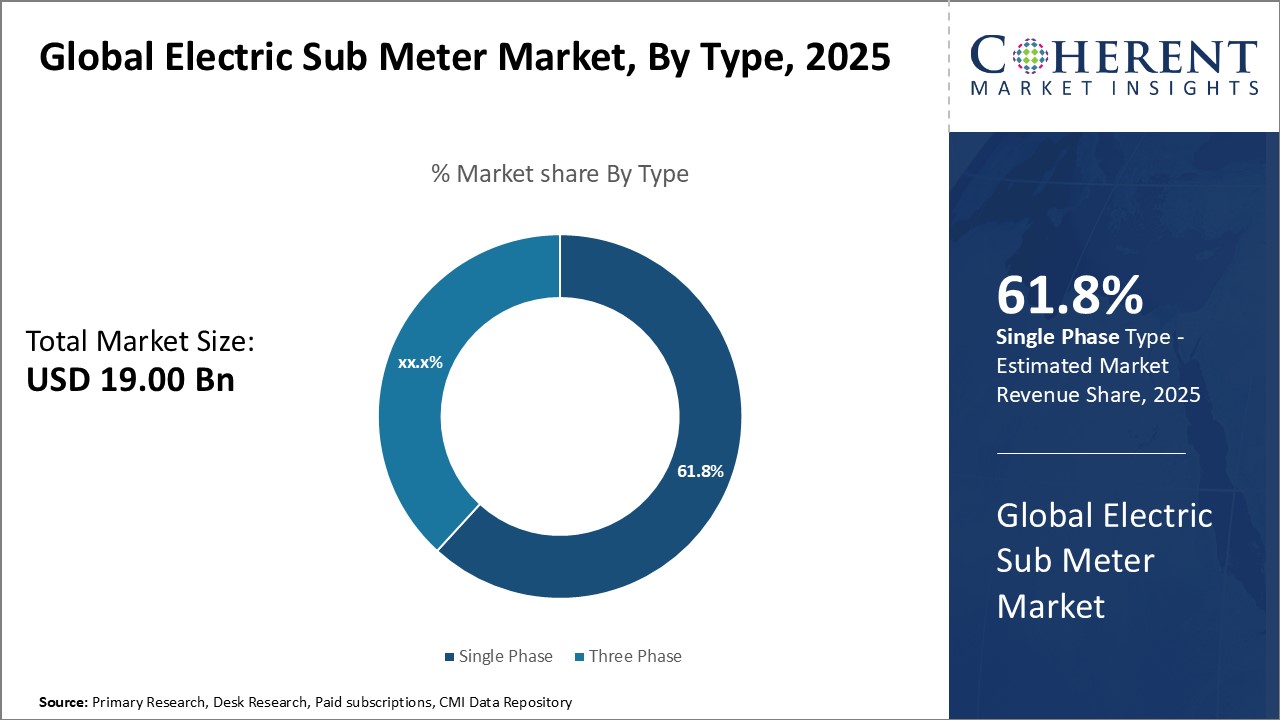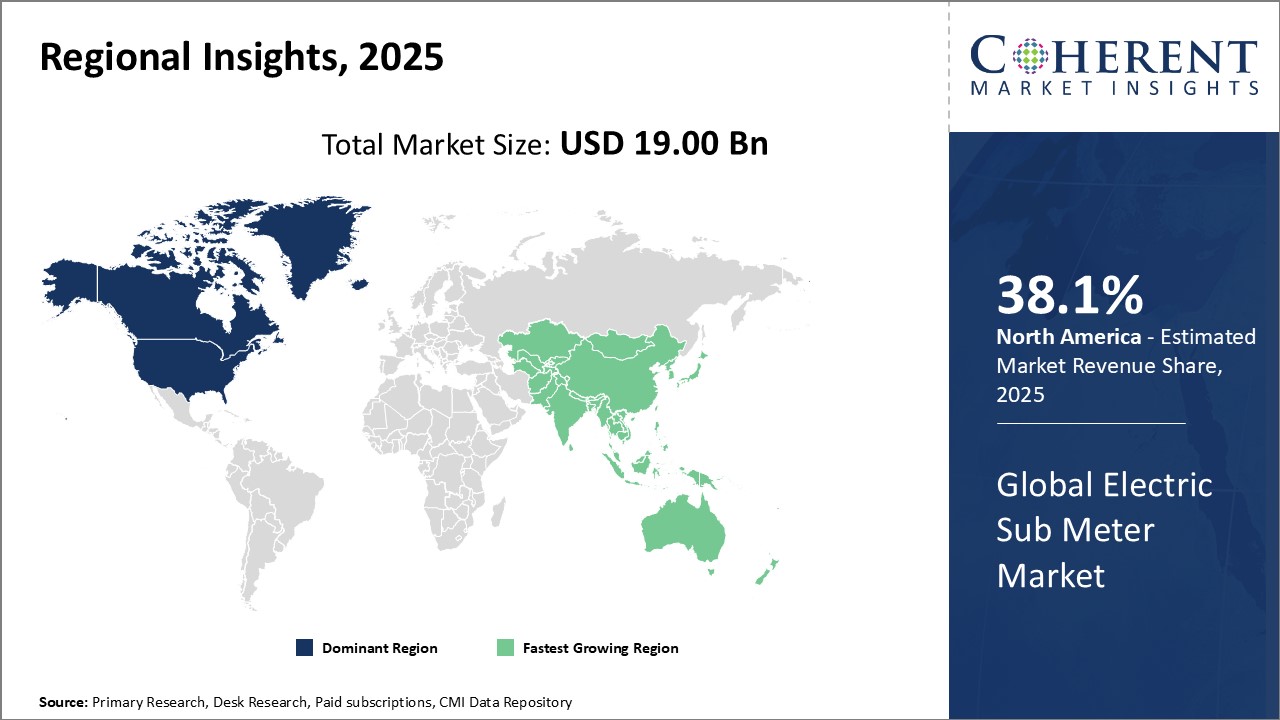Global Electric Sub Meter Market Size and Trends
Global electric sub meter market is estimated to be valued at US$ 19.00 Bn in 2025 and is expected to reach US$ 30.54 Bn by 2032, exhibiting a compound annual growth rate (CAGR) of 7.0% from 2025 to 2032.

Discover market dynamics shaping the industry: Download Free Sample
Rapid urbanization and growth of residential sector across developing nations can boost demand for electric sub meters over the forecast period. .
Market Driver - Increasing adoption of renewable energy sources
With growing global concern over climate change and depleting natural resources, many countries are transitioning to renewable sources of energy such as solar and wind power. These sources are advantageous as these are sustainable and reduce dependence on fossil fuels. However, integration of renewable energy into existing power infrastructure poses certain challenges. Renewable sources produce intermittent energy which needs to be effectively managed and stored. This boosts investments in upgrading and strengthening domestic power grids.
Electric sub meters enable distributed and flexible use of renewable energy. Operators of renewable energy plants can sell surplus power generated to commercial establishments and residential communities through local distribution networks monitored by sub meters. This creates an additional revenue stream to boost returns on investments in renewable projects. Users benefit from access to cleaner energy at competitive rates. Sub meters also help utilities better understand energy flow patterns and losses, thus, improving grid management. These act as a bridge to transport renewable power into conventional systems and maximize its usage.
As renewable capacity grows globally, sub meter installation will follow suit to facilitate optimal integration and distribution. Countries with aggressive renewable targets will witness demand. The Middle East is also diversifying energy mixes and rolling out massive solar PV plants, raising need for sub meters to track decentralized renewable offtake. Asia Pacific region is witnessing a major renewable expansion due to policy pushes and technology cost declines.
Market Concentration and Competitive Landscape

Get actionable strategies to beat competition: Download Free Sample
Rising demand for energy efficiency and cost savings
With rising energy consumption across sectors, there has been increasing need to curb wastage and optimize usage. Industries, businesses and households are looking to reduce electricity bills through efficient energy management practices. Sub meters are a cost-effective solution to monitor real-time and historical energy consumption data at a granular level. These help users pinpoint areas of major losses like from outdated equipment or habits. This supports targeted efforts to cut waste and increase efficiency. For example, sub meter data reveals peak period usage allowing adjustments to activities for savings.
Energy constitutes a major overhead for many organizations. Minimizing this expenditure through sub meter driven efficiency can significantly ease financial pressures. Utilities desire fewer network losses for their own benefits and to keep tariff hikes minimal. Sub meters empower all stakeholders to make data-led decisions in slashing energy bills and transitioning to more sustainable operations.
As the affordability of sub meter technology improves, more segments will institute widespread installations. Residential adopters have been growing as household budgets come under scanner and eco-awareness increases. Even developed nations are boosting existing building efficiency partly through sub meter rollout which guides optimization of devices, heating/cooling and usage patterns. The markets prospects depend on expanding realization regarding benefits of strategic energy management for profits as well as environmental goals.
Key Takeaways from Analyst:
Global electric sub meter market growth is driven by rising awareness about energy conservation across both residential and commercial sectors globally. Many countries are implementing policies and regulations that mandate the installation of electric sub meters in multi-tenant buildings to monitor individual unit consumption and encourage conservation. Rising need for accurate billing and cost allocation for shared utilities in housing societies, malls and office spaces can also drive the market growth.
Additional costs associated with procuring and installing sub meters can hamper the market growth as building owners may be reluctant to invest initially.
The North America region dominates the global market, owing to supportive government policies, large development projects and rapid urbanization. Meanwhile, Asia Pacific will remain the second largest market due to stringent energy efficiency programs. Europe will grow at a steady pace due to the region's focus on renewable energy and net-zero commitments. Developing markets will witness the fastest growth in adoption over the coming years as awareness increases.
Market Challenge - High initial investment and installation costs
Global electric sub meter market growth can be hampered due to high initial investment and installation costs associated with electric sub meters. Installation of electric sub meters requires significant upfront capital expenditure as professional help is needed for the installation process, which adds to the overall cost. Materials used for manufacturing sub meters such as modules, sensors and connectivity hardware are also expensive. Furthermore, additional costs are incurred for setting up the network infrastructure needed to transmit real-time meter data to central systems. These high initial costs create reluctance among building owners and facility managers to install sub meters. The payback period for these investments tend to be longer, which discourages certain segments. Moreover, additional installation expenditures are needed if the existing electrical wiring needs upgrades to support sub meters. These supply-side challenges of the market need to be addressed to accelerate adoption rates.
Opportunity- Growing demand for real-time energy monitoring and management
Growing demand for real-time energy monitoring and management solutions can offer opportunities for global electric sub meter market growth. With rising electricity costs and focus on energy efficiency, owners of multi-tenant commercial and residential buildings are increasingly realizing the benefits of sub meters. Installation of sub meters allows tracking of energy consumption patterns in granular level, which helps identify wastage and adopt measures to optimize usage. This leads to cost savings. Further, sub meters provide flexibility to apportion utility costs fairly based on actual consumption. These also help comply with government regulations in some countries regarding energy audits. With the availability of low-cost connectivity options and analytics tools, sub meters are enabling data-driven management of energy consumption. This boosts demand for sub meters across different end-use industries .

Discover high revenue pocket segments and roadmap to it: Download Free Sample
By Type- Affordability and convenience boosts adoption of single phase sub meters
In terms of type, single phase segment is expected to contribute the highest market share of 61.8% in 2025, owing to its affordability and convenience as compared to the three phase variant. Being less complex in design and requiring fewer components, single phase sub meters are significantly cheaper to manufacture. This lower upfront cost makes them highly attractive for residential and smaller commercial establishments with lower energy consumption.
Single phase sub meters are also easier to install as these only require connections to the live and neutral lines of the single phase power supply. This plug-and-play nature enables even non-technical users to install them with minimal hassle. In contrast, three phase meters involve handling three live lines along with the neutral and ground lines, making their installation more intricate. The simplified installation of single phase sub meters boosts its adoption rates especially in developing markets where technical skills may be limited.
Their compact size allows single phase sub meters to be easily retrofitted even in spaces with spatial constraints. This has boosted their popularity for metering individual units within large residential apartment complexes or commercial buildings. The small form factor also means single phase sub meters occupy very little additional space and pose minimal infrastructure upgrade requirements.
Lower costs and greater convenience of single phase sub meters has led to widespread use among residential and small commercial customers. As long as energy consumption remains modest, the affordability and ease of use of single phase variants will drive the segment growth.
By Application- Residential sector demand drives highest market share for application in electricity sub metering
In terms of application, residential segment is expected to contribute the highest market share of 47.3% in 2025, due to robust demand from the housing sector. Rapid urbanization and population growth have resulted in a large number of new residential constructions across both developing and developed regions. This has boosted demand for sub metering individual units within large apartment buildings and gated communities.
Residential customers are also highly cost-conscious when it comes to energy bills. Sub metering allows splitting costs proportionally based on actual consumption which encourages energy savings. Moreover, individual metering establishes billing accountability and prevents disputes over unexpected high collective bills. This has made sub metering an attractive proposition for both residential end users and building owners/developers.
Residential buildings also typically involve metering a large number of units often spread across multiple floors or blocks. This creates advantages of scale for sub meter suppliers catering to the housing sector. Standardized installations and bulk purchasing also helps lower per-unit equipment and integration costs. Thus, suppliers prioritize developing versatile sub metering solutions tailored to the needs of the residential segment.
Due to ongoing trends of urban living and emphasis on energy efficiency, there will be huge demand for sub metering from the residential sector. This will sustain its leadership position as the highest revenue generating application within the electric sub meter market.
By End User- Need to unbundle costs drives utility companies' preference for electric sub metering
In terms of end user, utility companies segment is expected to account for the highest market share of 48.7% in 2025, owing to initiatives aimed at unbundling energy costs. Traditionally, utilities would aggregate consumption from entire cities/regions and charge flat volumetric tariffs to consumers. However, rising energy costs and need for demand-side management has prompted them to shift to more granular billing.
Sub metering installed by utilities helps attribute consumption and demand at distribution level, thus, establishing an accurate per-user energy profile. This facilitates moving to demand-based or time-of-use tariffs with pricing incentives for off-peak usage. It also enables utilities to bill commercial/industrial clients directly based on actual power drawn rather than undefined collective contracts. Both strategies help utilities better manage grid stress and optimize supply-demand balance.
For utilities, sub metering also removes the necessity to invest in individual smart meter rollouts or manage lengthy retrofitting programs. Installed and managed by third parties, the electric sub meters achieve the same objective of disaggregated data collection and billing in a more cost-effective decentralized manner. This has led several power distribution companies to either mandate sub metering in large consumer premises or actively promote the practice.
Regional Insights

Need a Different Region or Segment? Download Free Sample
North America dominates the global electric sub meter market with an estimated market share of 38.1% in 2025, due to the strong presence of major manufacturers in the region. Countries like the U.S. and Canada have witnessed huge adoption of electric sub meters in commercial as well as residential buildings due to supportive government regulations and awareness drives around energy efficiency.
A large number of tier-1 manufacturers are headquartered in North America, allowing for easy access to advanced technologies and local expertise. Over the years, manufacturers have invested heavily in R&D to develop innovative products tailored for the regional customer needs such as compact designs and integration with local communication protocols. This has helped them maintain strong customer relationships and market share.
Open trade policies and proximity to key markets have enabled North American manufacturers to export products globally at competitive prices. The region also attracts skilled workforce and talent which boosts innovation. The well-developed market and manufacturing ecosystem makes North America highly conducive for electric sub meter businesses.
Asia Pacific has emerged as the fastest growing market. Countries like China, Japan and India offer massive growth potential due to rising focus on renewable energy and energy conservation. Rapid urbanization has boosted demand for electric sub meters in the commercial, industrial and residential infrastructure being developed.
The availability of low-cost labor and raw materials in Asia Pacific allows local manufacturers to offer competitive prices. This has boosted adoption especially in price-sensitive markets. Additionally, governments of developing nations promote energy efficiency programs which create demand. For instance, in China the State Electricity Regulatory Commission has made installation of electric sub meters mandatory in certain commercial buildings.
The confluence of supportive policies, growing economies of scale and burgeoning end-use sectors makes Asia Pacific an attractive production and market hub for the electric sub meter industry.
Market Report Scope
Global Electric Sub Meter Market Report Coverage
| Report Coverage | Details | ||
|---|---|---|---|
| Base Year: | 2024 | Market Size in 2025: | USD 19.00 Bn |
| Historical Data for: | 2020 To 2024 | Forecast Period: | 2025 To 2032 |
| Forecast Period 2025 to 2032 CAGR: | 7.0% | 2032 Value Projection: | USD 30.54 Bn |
| Geographies covered: |
|
||
| Segments covered: |
|
||
| Companies covered: |
Aclara Technologies LLC, Apator Group, Badger Meter, Inc., Diehl Stiftung& Co. KG, Eaton Corporation plc, Elster Group GmbH (Honeywell), General Electric Company, Holley Metering Limited, Itron Inc., Kamstrup A/S, Landis+Gyr AG, Legrand SA, Mitsubishi Electric Corporation, Schneider Electric SE, and Siemens AG |
||
| Growth Drivers: |
|
||
| Restraints & Challenges: |
|
||
Uncover macros and micros vetted on 75+ parameters: Get instant access to report
Market Segmentation
- Type Insights (Revenue, US$ Bn, 2020 - 2032)
-
- Single Phase
- Three Phase
- Application Insights (Revenue, US$ Bn, 2020 - 2032)
-
- Residential
- Commercial
- Industrial
- End User Insights (Revenue, US$ Bn, 2020 - 2032)
-
- Utility Companies
- Building Owners
- Industrial Facilities
- Regional Insights (Revenue, US$ Bn, 2020 - 2032)
- North America
- U.S.
- Canada
- Latin America
- Brazil
- Argentina
- Mexico
- Rest of Latin America
- Europe
- Germany
- U.K.
- Spain
- France
- Italy
- Russia
- Rest of Europe
- Asia Pacific
- China
- India
- Japan
- Australia
- South Korea
- ASEAN
- Rest of Asia Pacific
- Middle East
- GCC Countries
- Israel
- Rest of Middle East
- Africa
- South Africa
- North Africa
- Central Africa
- North America
- Key Players Insights
- Aclara Technologies LLC
- Apator Group
- Badger Meter, Inc.
- Diehl Stiftung & Co. KG
- Eaton Corporation plc
- Elster Group GmbH (Honeywell)
- General Electric Company
- Holley Metering Limited
- Itron Inc.
- Kamstrup A/S
- Landis+Gyr AG
- Legrand SA
- Mitsubishi Electric Corporation
- Schneider Electric SE
- Siemens AG
Share
Share
About Author
Ameya Thakkar is a seasoned management consultant with 9+ years of experience optimizing operations and driving growth for companies in the automotive and transportation sector. As a senior consultant at CMI, Ameya has led strategic initiatives that have delivered over $50M in cost savings and revenue gains for clients. Ameya specializes in supply chain optimization, process re-engineering, and identification of deep revenue pockets. He has deep expertise in the automotive industry, having worked with major OEMs and suppliers on complex challenges such as supplier analysis, demand analysis, competitive analysis, and Industry 4.0 implementation.
Missing comfort of reading report in your local language? Find your preferred language :
Transform your Strategy with Exclusive Trending Reports :
Frequently Asked Questions
EXISTING CLIENTELE
Joining thousands of companies around the world committed to making the Excellent Business Solutions.
View All Our Clients
